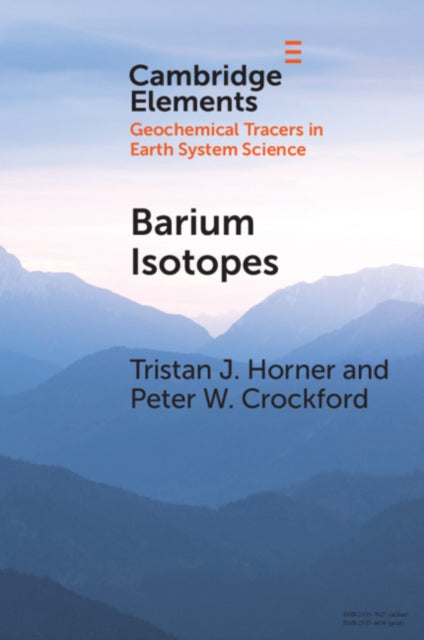Tristan J.Horner,Peter W.Crockford
Barium Isotopes: Drivers, Dependencies, and Distributions through Space and Time
Barium Isotopes: Drivers, Dependencies, and Distributions through Space and Time
YOU SAVE £0.86
- Condition: Brand new
- UK Delivery times: Usually arrives within 2 - 3 working days
- UK Shipping: Fee starts at £2.39. Subject to product weight & dimension
Bulk ordering. Want 15 or more copies? Get a personalised quote and bigger discounts. Learn more about bulk orders.
Couldn't load pickup availability
- More about Barium Isotopes: Drivers, Dependencies, and Distributions through Space and Time
Barite cycling, which is the process by which barite incorporates light Ba isotopes from solution and leaves the residual Ba reservoir enriched in heavy Ba isotopes, drives systematic variations in the barium isotope composition of seawater and sediments. This study examines these variations, evaluates their global, regional, local, and geological controls, and explores how δ138Ba can be used to constrain the origin of enigmatic sedimentary sulfates and to study marine biogeochemistry over Earth's history.
Format: Paperback / softback
Length: 75 pages
Publication date: 22 April 2021
Publisher: Cambridge University Press
In the intricate realm of modern marine ecosystems, barium isotope (δ138Ba) fluctuations take center stage, primarily driven by the dynamic process of barite cycling. Barite, a mineral rich in barium, plays a pivotal role in this cycle by incorporating light Ba isotopes from the surrounding solution, thereby enriching the residual Ba reservoir with heavy Ba isotopes in a complementary manner. The fascinating aspect of barite cycling lies in its vertical segregation and spatially heterogeneous nature, which leads to systematic variations in the barium isotope composition of seawater and sediments.
This Element delves into these intriguing variations, assessing their global, regional, local, and geological controls. It also explores the potential of δ138Ba as a powerful tool for unraveling the enigmatic origins of sedimentary sulfates and for studying marine biogeochemistry throughout Earth's history.
Barite precipitation and dissolution processes occur in distinct vertical zones and heterogeneous spatial regions within the marine environment. As a result, barite cycling generates systematic variations in the barium isotope composition of seawater and sediments. These variations can be attributed to various factors, including the distribution of barite sources, water circulation patterns, and biological processes that influence barite growth and dissolution rates.
One of the key insights gained from studying barite cycling is its ability to provide insights into the origin and evolution of sedimentary sulfates. Sedimentary sulfates are a diverse group of minerals that are formed through the chemical reaction of sulfuric acid with minerals such as calcium, magnesium, and iron. The δ138Ba composition of sedimentary sulfates can vary depending on the source of sulfuric acid and the environmental conditions during their formation. By analyzing the δ138Ba composition of sedimentary sulfates, researchers can trace the source of sulfuric acid and reconstruct the geological history of the regions where these minerals were deposited.
Barite cycling also plays a crucial role in understanding marine biogeochemistry over Earth's history. The δ138Ba composition of seawater and sediments can be used as a proxy for past environmental conditions, such as temperature, salinity, and atmospheric carbon dioxide levels. By studying the variations in δ138Ba over time, researchers can gain insights into past climate changes and their impact on marine ecosystems.
In conclusion, barium isotope (δ138Ba) variations in the modern marine environment are primarily driven by barite cycling, a complex process that involves the incorporation of light and heavy Ba isotopes from solution. This cycling process leads to systematic variations in the barium isotope composition of seawater and sediments, providing valuable insights into the origin and evolution of sedimentary sulfates and marine biogeochemistry over Earth's history.
Weight: 84g
Dimension: 151 x 228 x 8 (mm)
ISBN-13: 9781108791113
This item can be found in:
UK and International shipping information
UK and International shipping information
UK Delivery and returns information:
- Delivery within 2 - 3 days when ordering in the UK.
- Shipping fee for UK customers from £2.39. Fully tracked shipping service available.
- Returns policy: Return within 30 days of receipt for full refund.
International deliveries:
Shulph Ink now ships to Australia, Belgium, Canada, France, Germany, Ireland, Italy, India, Luxembourg Saudi Arabia, Singapore, Spain, Netherlands, New Zealand, United Arab Emirates, United States of America.
- Delivery times: within 5 - 10 days for international orders.
- Shipping fee: charges vary for overseas orders. Only tracked services are available for most international orders. Some countries have untracked shipping options.
- Customs charges: If ordering to addresses outside the United Kingdom, you may or may not incur additional customs and duties fees during local delivery.


